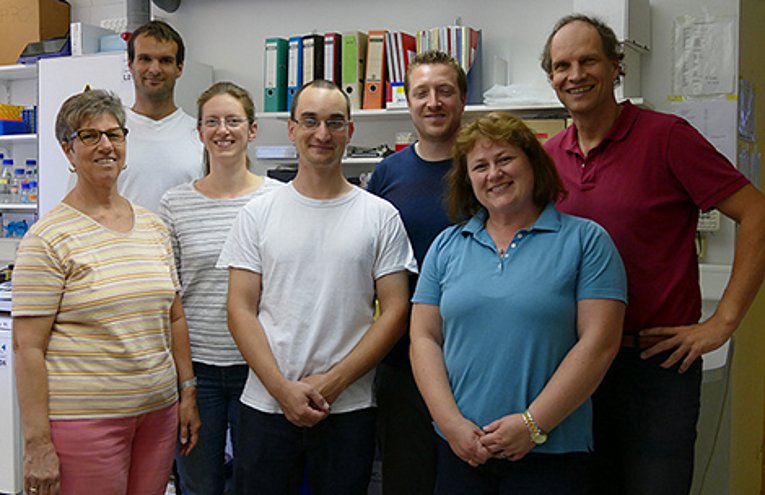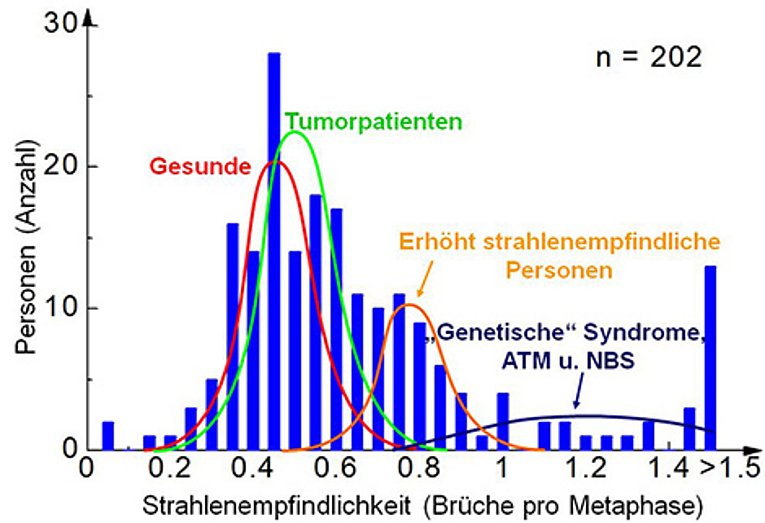Why are there people with different radiation sensitivity?
Individual radiation sensitivity describes how the cells of an individual can deal with the damage to DNA caused by radiation. This includes not only that the damage to the DNA is repaired, but also that information about the number and severity of the damage is adequately passed on within the cell. Furthermore, the cell must then react correctly and, for example, stop cell division or, in the case of particularly serious damage, ensure that it can never divide again. All these steps together are called damage processing.
Several hundred different proteins or genes are needed for damage processing. Even small changes (polymorphisms and mutations) in these genes can lead to an altered damage processing. This then means that humans are more sensitive to radiation and other agents that damage DNA.
Individual radiation sensitivity
As a result of the characteristics of these different genes, each person has a specific radiation sensitivity, which describes how the person can deal with the damage caused by radiation. Radiation sensitivity can be tested by various methods, e.g. by irradiating blood cells ex vivo and then examining the repair and further processing of the damage. We use as standard the examination of blood lymphocytes, which we irradiate with 2 Gy and then let grow. After 48 hours we examine in the first division phase which damages remained from the irradiation. This damage is expressed in breaks per division (breaks per metaphase) and above this, an increased radiation sensitivity can be very well reflected. If the values are increased to more than 0.55 fractions per metaphase, we strongly recommend reducing the daily doses of radiation therapy accordingly.
Genetic syndromes
There are a number of genetic diseases with different symptoms, which in addition often cause increased sensitivity to radiation. Better known syndromes are Fanconi Syndrome, Ataxia Telangiectatica and Nijmegen Breakage Syndrome. In all syndromes the degree of radiation sensitivity is not always the same. In Fanconi syndrome there are patients who are not increased and others who are significantly increased radiation sensitive.
| Genetic syndromes with increased radiation sensitivity: | |
|---|---|
| Ataxia Telangiectatica (ATM) | ATLD / Mre11 |
| Cockayne-syndrome | Bloom-syndrome |
| DNA-PK | Fanconi Anämie |
| Ligase IV | Nijmegen Breakage syndrome |
| Rett syndrome | Rothmund-Thomson-syndrome |
| SCID-Artemis | Trichothiodsytrophie |
| Werner-syndrome | Xeroderma pigmentosum |
Familial cancer diseases
However, there are also genes that are passed on in families that do not cause disease, but which lead to familial cancer and may also be associated with increased radiation sensitivity. The cause of familial cancer may be increased sensitivity to radiation, which may also cause increased sensitivity to other agents such as carcinogenic chemicals. The impaired damage processing then leads to increased changes in the genes and can cause cancer. An indication of such a constellation are several cases of cancer in siblings, parents and grandparents. A young age of illness earlier than before the age of 45 to 50 and the occurrence of several cancers also indicate a possible increased individual radiation sensitivity.
| Familial cancers are present in the following syndromes: |
|---|
| Familial breast cancers (BRCA1/2) |
| Li Fraumeni syndrome |
| HNPCC / Lynch syndrome |





